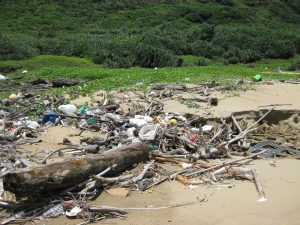In February I penned an article arguing that fear-based climate messaging often drives people to despondency and apathy rather than climate action. In this post, I’d like to offer a counter example of how positive, thoughtful climate messaging can inspire people to want to do better. I am grateful to the students and teachers at St. Margaret’s school, Minister George Heyman and the students in my EOS 365 (Climate and Society) class for participating and contributing to an intergenerational conversation on climate change on Monday, March 4, 2024.
 EOS 365 (Climate and Society) is a course I developed at UVic and first offered in 2009. The lectures follow the chapters in the book Keeping Our Cool: Canada in a Warming World that I first published in 2008. In the course I survey the climate system and its interaction with past, present, and future societies, including the onset of agriculture/domestication of animals in the Holocene, the rise and fall of early civilizations, the Anthropocene and global warming. Early in the course I teach a module on science communication. I emphasize that if one wants to advance lasting climate solutions, then one must bring people with you rather than alienating those who may not wish to prioritize climate action. I point out that politicians are elected to represent everyone, not just their support base, and so policy makers need to listen and respond to the views of all stakeholders.
EOS 365 (Climate and Society) is a course I developed at UVic and first offered in 2009. The lectures follow the chapters in the book Keeping Our Cool: Canada in a Warming World that I first published in 2008. In the course I survey the climate system and its interaction with past, present, and future societies, including the onset of agriculture/domestication of animals in the Holocene, the rise and fall of early civilizations, the Anthropocene and global warming. Early in the course I teach a module on science communication. I emphasize that if one wants to advance lasting climate solutions, then one must bring people with you rather than alienating those who may not wish to prioritize climate action. I point out that politicians are elected to represent everyone, not just their support base, and so policy makers need to listen and respond to the views of all stakeholders.
I also suggest to the students that whether or not society wants to deal with global warming really boils down to one question:
Do we the present generation owe anything to future generations in terms of the quality of the environment we leave behind. Yes? or No?
 Science can’t answer that question. But science tells us why this is ultimately the question that needs to be asked. If the answer is yes, then we have no choice but to immediately take steps to decarbonize energy systems for the consequences of unchecked emission growth are profound (widespread species extinction and unparalleled geopolitical instability). If the answer is no, then who cares about global warming?
Science can’t answer that question. But science tells us why this is ultimately the question that needs to be asked. If the answer is yes, then we have no choice but to immediately take steps to decarbonize energy systems for the consequences of unchecked emission growth are profound (widespread species extinction and unparalleled geopolitical instability). If the answer is no, then who cares about global warming?
In class I also note that formulating climate policy is often inconsistent with a four year political cycle as the effects of the policy decisions made today will not be felt in the political lifetime of those making the decisions. Yet these same politicians will not be around in the future to be held accountable for the decisions they did or did not make. And so policies with demonstrable short-term outcomes often take precedence over climate policy. Allocating resources to advance short term “wins” will allow you to point to your political successes in a few years and proclaim “I was responsive to your needs; please re-elect me and I will do more”. It’s next to impossible to do the same with climate policy. But I would argue that there is a moral and ethical imperative to advance climate solutions now if society believes in the importance of intergenerational equity.
 Building on the themes of effective climate communication and intergenerational equity, I hosted an event in EOS 365 on March 4 inspired by the Grade 7 (and 8) students at St. Margaret’s School, Victoria BC. Four generations were involved in the conversation: 1) the St. Margaret’s students; 2) the UVic students; 3) the teachers from St. Margaret’s; 4) the Honourable George Heyman (Minister of Environment and Climate Change Strategy) and me.
Building on the themes of effective climate communication and intergenerational equity, I hosted an event in EOS 365 on March 4 inspired by the Grade 7 (and 8) students at St. Margaret’s School, Victoria BC. Four generations were involved in the conversation: 1) the St. Margaret’s students; 2) the UVic students; 3) the teachers from St. Margaret’s; 4) the Honourable George Heyman (Minister of Environment and Climate Change Strategy) and me.
On February 1 2024, I attended St. Margaret’s Grade 7 Environmental Summit and was blown away by the insight and creativity of the students. The Grade 7 class had been learning about the socioeconomic and environmental ramifications of global warming. Students took on the role of an affected party (e.g. firefighter, fisher, pilot, business owner etc.) and researched how global warming was going to affect them. I listened to numerous testimonies from the Grade 7 students who role-played their chosen characters and was taken aback by their insight and how effectively, and articulately they were able to communicate their stories.
The highlight of the event for me was was when the Grade 7/8 St. Margaret’s choir sang a rendition of an SOS from the kids in front of all those in attendance.
 My March 4 class began with the St. Margaret’s grade 7/8 choir, led by Mike Keddy, setting the tone for the rest of our conversation by once more singing an SOS from the kids. At the end of the song, and as the final words “you can do better than this” were sung, Mike Keddy held up a Montreal Canadians pennant (indeed one can do better than that).
My March 4 class began with the St. Margaret’s grade 7/8 choir, led by Mike Keddy, setting the tone for the rest of our conversation by once more singing an SOS from the kids. At the end of the song, and as the final words “you can do better than this” were sung, Mike Keddy held up a Montreal Canadians pennant (indeed one can do better than that).
We were keeping things light and continuing the playful banter that had started at St. Margaret’s School when I noticed middle years teacher Michael Jones had decorated his classroom with some Edmonton Oilers swag. Michael arrived at my class wearing his Oilers jersey, while the TA for the class Katherine Martin proudly sported a Toronto Maple Leafs sweater. She was joined by middle years teacher and fellow Leaf’s fan Meaghan Thompson who showed up with a Leaf’s cap.
And of course, while noting the obvious irony, I adorned my Oilers jersey.
We were honoured to have Minister Heyman attend the class. He had just announced that he was not seeking reelection in the next provincial election moments before we started, and EOS 365 was his first public appearance following that announcement. Once the choir had finished, Minister Heyman spoke about CleanBC and how is government was responding to the challenge of global warming and capitalizing on the opportunity it provides for innovation and creativity in addressing the challenge.
Minister Heyman kindly agreed to allow the EOS 365 and St. Margaret’s students to quiz him in a “kinder and gentler” version of Question Period. First, a St. Margaret’s student read out their prepared script. Unfortunately, in the time available I could only select six students to speak: SO was the CEO of the world’s largest oil company; SW was the heiress to Lululemon; DS was a climate scientist; AM owned a Victoria-based construction contracting company; LA was a young cosmetic designer and owner of an eco-friendly company; TA was a Victoria-based frefighter.
 In advance of the class I had given six EOS 365 students copies of the scripts that were going to be read out (see the instagram reel at the end of this post). All six of these students were from the first cohort enrolled in UVic’s new BSc in Climate Science degree program. Each of these students asked the Minister a thoughtful yet probing question that they had prepared in advance and based on the script they were given. The Minister responded in an equally thoughtful way. I role-played the Speaker, and offered the class a supplementary question which was subsequently posed to the Minister. And so we proceeded to explore how the BC government was responding to climate change in six unique sectors.
In advance of the class I had given six EOS 365 students copies of the scripts that were going to be read out (see the instagram reel at the end of this post). All six of these students were from the first cohort enrolled in UVic’s new BSc in Climate Science degree program. Each of these students asked the Minister a thoughtful yet probing question that they had prepared in advance and based on the script they were given. The Minister responded in an equally thoughtful way. I role-played the Speaker, and offered the class a supplementary question which was subsequently posed to the Minister. And so we proceeded to explore how the BC government was responding to climate change in six unique sectors.
This particular class was perhaps the most enriching and rewarding experience I’ve ever had while teaching at the university level. And I started teaching in 1986! My sincere thanks to the students and teachers at St. Margaret’s School, the Minister and his staff, and the BSc in Climate Science and other students in EOS 365 for making this event so successful.
My hope in organizing this event was to demonstrate to my class how positive, hopeful, constructive and solutions-focused climate communication can inspire others to want to take climate action. Too often, activists use fear-based messaging, or outrageous acts of civil disobedience, like throwing soup on a priceless Van Gogh or disrupting traffic and creating chaos on local streets in an attempt to raise awareness as to the seriousness of climate change. As I have argued before, more often than not, such behaviour does little more than drive people to despondency and apathy rather than climate action.


















